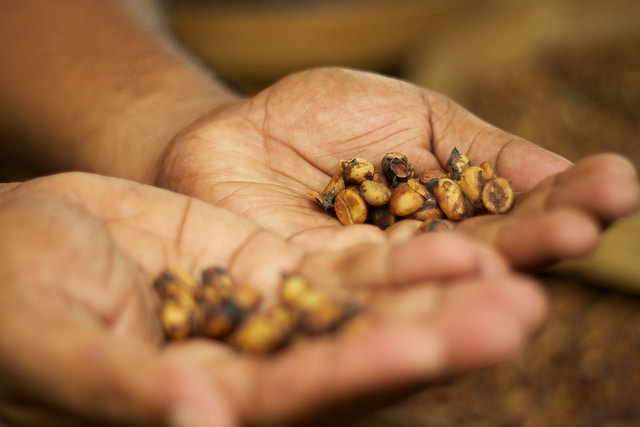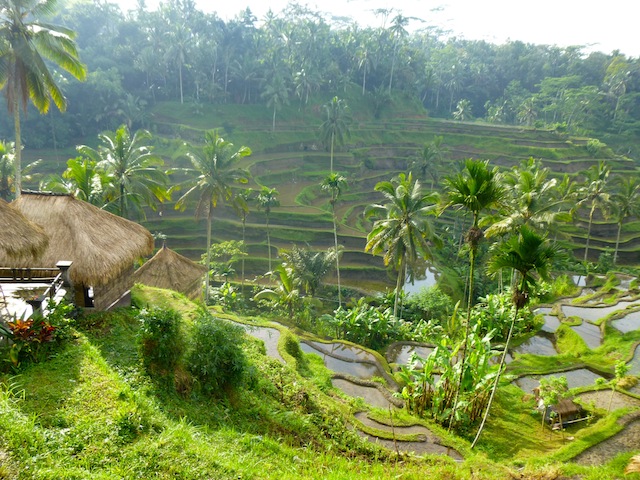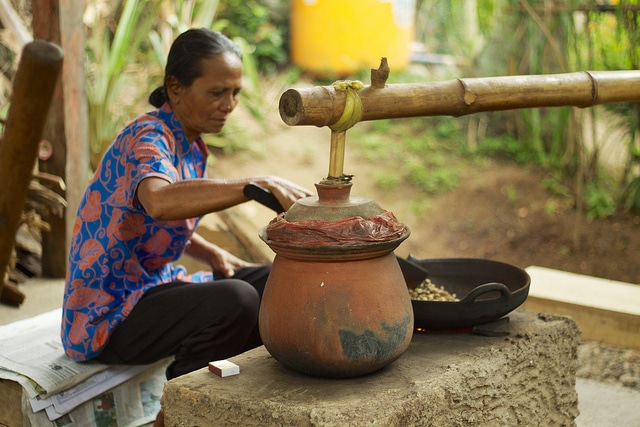
Bali, Indonesia. Prior to visiting, I pictured its white sand beaches as a haven for honeymooners and a hot spot for surfers. While all of this exists on the southern end of the island, there are also areas where one can get away from the sunscreen-slathered tourists. This is what I hoped to explore, and Ubud — the cultural heart of the island and a crossroad for traditional art, dance and music — was a great place to start.

Coffee plantation in Bali. Photo courtesy of Katie Foote.
Going Local On Tour
Life runs at a different pace when you’re living snuggled between rice paddies at the foothills of the steep Gianyar regency, and I wanted to submerse myself. I’m skeptical of tours that promise to show the “real” life of locals, but when a friend and well-respected world traveler recommended Bali EcoCycle Tour, I decided to give it a chance. It sounded too good to be true, especially when the company promised “throngs of Balinese children” lining the country roads, “calling out ‘hellos’ and wanting high fives on the way down”; however, the tour was everything promised and more.
We started with a breakfast of banana pancakes and black rice pudding, looking out over a crater lake reflecting an active volcano. We swung like monkeys from enormous Bunyan trees, munching on bananas. We got stuck in the mud, hiking through rice paddies on our way to greet a cow so cute we never wanted to eat beef again. We were welcomed into a Balinese compound where women made traditional handicrafts and danced Gangham-style with local children, rocking out to an old-school radio. Little piles of petals in bamboo boats literally lined the streets, doorsteps and gutters of Ubud, as women made daily offerings to appease the gods and keep away the demons. In the compound, we learned about Balinese Hindism — a unique facet of Bali compared to the rest of Indonesia — which houses one of the largest Islamic populations in the world.

Asian palm civet. Photo courtesy of dhruvaraj.
An Introduction To Kopi Luwak
While all these experiences were memorable, the highlight of the tour was trying Kopi Luwak, one of the most expensive and rare coffees in the world. Kopi — the Indonesian word for coffee — Luwak comes from Sumatra, Java and Sulawesi in Indonesia’s Archepelago islands. The beans that compose this coffee take an interesting path before the typical roasting, grinding and serving into your cup. Our tour guide introduced us to the residential Asian palm civet, the animal that makes the magic happen. These cat-like creatures eat the highest quality beans, partially digest the food’s fleshy exterior and excrete what’s left (thus, “cat-poo-chinno”). These excreted beans are cleaned, fermented, dried, roasted, ground and brewed to create the world-renowned coffee that is Kopi Luwak.

Legend has it that when Indonesia was a Dutch colony, plantation owners forbade workers from picking coffee beans for their own use. Apparently, a curious — and potentially desperate — soul might have picked out beans left in droppings of the civet and roasted them into what became a luxury item.
Since only a limited amount of beans are harvested this way, Kopi Luwak became one of the worlds’ priciest specialty coffees, sold for up to $180 a pound. The acids and enzymes in the civet’s stomach are said to impart a syrupy, heavy and full-bodied flavor, and a musty earthiness that is highly valued by coffee connoisseurs. There have even been efforts to exploit this lucrative market by making knock-offs that chemically mimic the effects of passing these beans through the digestive tract. Supposedly, the chemical reactions due to acids and enzymes in the civet’s stomach lead to a unique taste and flavor.
It has been said by U.S.-based food and drink critic and coffee connoisseur Chris Rubin, “The aroma is rich and strong, and the coffee is incredibly full bodied, almost syrupy,” he says. “It’s thick with a hint of chocolate, and lingers on the tongue with a long, clean aftertaste. It’s definitely one of the most interesting and unusual cups I’ve ever had.”
Sampling Local Kopi Culture
While in Bali, I decided to subdue the slight nausea that came with imagining drinking a beverage that came out the rear end of a fur ball, and ordered a cup. A woman in traditional clothing constructed a water-boiling contraption then poured me a mug of this thick consistency caffeinated concoction. I braced myself for feline funkiness, but the coffee was pretty anti-climatic, in a good way. Although I was not instantly transported into swirls of syrupy chocolate, it certainly wasn’t undrinkable. I’m glad I tried it for the novelty, however, my future coffee orders will remain “cream and sugar, hold the digestive enzymes!”
Contributed guest post by Katie Foote, a doctoral student who loves exploring the world every chance she gets.
Photo credit (top) Luwak coffee beans and last photo – Photo courtesy of McKay Savage.

Jessica Festa is the editor of the travel sites Jessie on a Journey (http://jessieonajourney.com) and Epicure & Culture (http://epicureandculture.com). Along with blogging at We Blog The World, her byline has appeared in publications like Huffington Post, Gadling, Fodor’s, Travel + Escape, Matador, Viator, The Culture-Ist and many others. After getting her BA/MA in Communication from the State University of New York at Albany, she realized she wasn’t really to stop backpacking and made travel her full time job. Some of her most memorable experiences include studying abroad in Sydney, teaching English in Thailand, doing orphanage work in Ghana, hiking her way through South America and traveling solo through Europe. She has a passion for backpacking, adventure, hiking, wine and getting off the beaten path.








